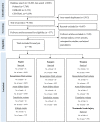Resuscitation fluid types in sepsis, surgical, and trauma patients: a systematic review and sequential network meta-analyses
- PMID: 33317590
- PMCID: PMC7734863
- DOI: 10.1186/s13054-020-03419-y
Resuscitation fluid types in sepsis, surgical, and trauma patients: a systematic review and sequential network meta-analyses
Abstract
Background: Crystalloids and different component colloids, used for volume resuscitation, are sometimes associated with various adverse effects. Clinical trial findings for such fluid types in different patients' conditions are conflicting. Whether the mortality benefit of balanced crystalloid than saline can be inferred from sepsis to other patient group is uncertain, and adverse effect profile is not comprehensive. This study aims to compare the survival benefits and adverse effects of seven fluid types with network meta-analysis in sepsis, surgical, trauma, and traumatic brain injury patients.
Methods: Searched databases (PubMed, EMBASE, and Cochrane CENTRAL) and reference lists of relevant articles occurred from inception until January 2020. Studies on critically ill adults requiring fluid resuscitation were included. Intervention studies reported on balanced crystalloid, saline, iso-oncotic albumin, hyperoncotic albumin, low molecular weight hydroxyethyl starch (L-HES), high molecular weight HES, and gelatin. Network meta-analyses were conducted using random-effects model to calculate odds ratio (OR) and mean difference. Risk of Bias tool 2.0 was used to assess bias. Confidence in Network Meta-Analysis (CINeMA) web application was used to rate confidence in synthetic evidence.
Results: Fifty-eight trials (n = 26,351 patients) were identified. Seven fluid types were evaluated. Among patients with sepsis and surgery, balanced crystalloids and albumin achieved better survival, fewer acute kidney injury, and smaller blood transfusion volumes than saline and L-HES. In those with sepsis, balanced crystalloids significantly reduced mortality more than saline (OR 0.84; 95% CI 0.74-0.95) and L-HES (OR 0.81; 95% CI 0.69-0.95) and reduced acute kidney injury more than L-HES (OR 0.80; 95% CI 0.65-0.99). However, they required the greatest resuscitation volume among all fluid types, especially in trauma patients. In patients with traumatic brain injury, saline and L-HES achieved lower mortality than albumin and balanced crystalloids; especially saline was significantly superior to iso-oncotic albumin (OR 0.55; 95% CI 0.35-0.87).
Conclusions: Our network meta-analysis found that balanced crystalloids and albumin decreased mortality more than L-HES and saline in sepsis patients; however, saline or L-HES was better than iso-oncotic albumin or balanced crystalloids in traumatic brain injury patients.
Trial registration: PROSPERO website, registration number: CRD42018115641).
Keywords: Colloids; Crystalloids; Fluid therapy; Intensive care; Resuscitation.
Conflict of interest statement
The authors declare that they have no competing interests.
Figures





References
Publication types
MeSH terms
Substances
LinkOut - more resources
Full Text Sources
Medical

